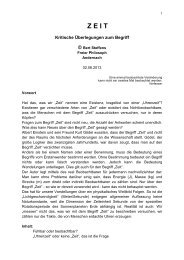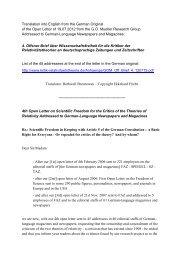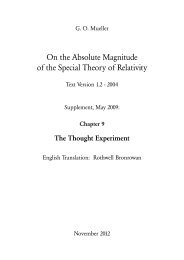2394 weitere kritische Veröffentlichungen - Kritische Stimmen zur ...
2394 weitere kritische Veröffentlichungen - Kritische Stimmen zur ...
2394 weitere kritische Veröffentlichungen - Kritische Stimmen zur ...
Erfolgreiche ePaper selbst erstellen
Machen Sie aus Ihren PDF Publikationen ein blätterbares Flipbook mit unserer einzigartigen Google optimierten e-Paper Software.
Auch unter: http://freespace.virgin.net/ch.thompson1/<br />
Papers/Miller40.htm. - Status: Kritik. - Quelle: Autopsie.<br />
Miller, Michael 2005<br />
Causality, measurement and space: (C) 1999 / Michael<br />
Miller. - [Kanada]: WWW 2005. Ca. 15 S.<br />
In: The rational argumentator. A journal for western<br />
man. 2005, Issue 30, January 21.<br />
URL: http://rationalargumentator.com/issue30/<br />
causality.html - Status: Kritik. - Quelle: Autopsie.<br />
Miller, Michael 2005<br />
Time, clocks and causality: (C) 1997 / Michael Miller.<br />
- [Kanada]: WWW 2005. Ca. 15 S.<br />
In: The rational argumentator. A journal for western<br />
man. 2005, Issue 30, January 28.<br />
URL: http://rationalargumentator.com/issue30/<br />
Miller_time.html - Status: Kritik. - Quelle: Autopsie.<br />
Milnes, Harold Willis 1983<br />
Faster than light?.<br />
In: Radio electronics. 54. 1983, N1, Januar.<br />
Status: Kandidat. - Quelle: Millenium Twain 1995<br />
(The undiscovered physics).<br />
Milnes, Harold Willis 1984<br />
On electric signals exceeding the velocity of light.<br />
In: Toth-Maatian review. 2. 1984, S. 870-890.<br />
Status: Kandidat. - Quelle: Mitsopoulos 2001 (Similarity).<br />
Minhas, I. S. 2004<br />
Special relativity prescribes a new definition of measurement<br />
[Part 1]: [datiert: 15.4.04] / I. S. Minhas.<br />
In: The general science journal. 2004 =<br />
http://wbabin.net/physics/minhas.htm - 5 S.<br />
SRT. LK. C. MESS.<br />
Auszug: "Abstract - It is brought out that special<br />
relativity is afflicted with an inconsistency which can<br />
be removed only by postulating that light is not an electromagnetic<br />
phenomenon but is associated in an identical<br />
manner with all phenomena. A clue to the nature of this<br />
association is given by an analysis of length contraction<br />
which shows that light is necessarily involved in the<br />
operations of measuring length and that these operations<br />
are the same for all inertial observers. This entails a<br />
new definition of the term "measurement." (...)<br />
Now, there are a few points which make the link<br />
alleged by Einstein (and accepted ex cathedra by Bridgman<br />
and others) between length contraction and his<br />
procedures (a) and (b) look suspicious. For example,<br />
consider another inertial frame S' in which also the rod<br />
R is moving parallel to its length but with a speed v'<br />
which is different from its speed v in S. According to<br />
special relativity, its length l' as measured by the observer<br />
in S' is given by [4]<br />
l' = lo (1 - v'²/c²)[½] . (2)<br />
This observer has to necessarily use the same procedure<br />
for the measurement of l' as that used by the observer<br />
in S for the measurement of l because the rod is<br />
moving relative to both of them. So we have the observers<br />
in frames S and S' measuring the length of the rod<br />
using identical procedures and yet obtaining different<br />
results, l and l', respectively. Now, special relativity has<br />
the same explanation for the difference of l and l' as that<br />
for the difference of l and l[o]; thus, l is different from l'<br />
because v is different from v', and l is different from lo<br />
because v is different from zero. But the explanation<br />
which Einstein [5,6], Bridgman [7] and others concerned<br />
give for the difference of l and l[o], namely, in terms of<br />
different procedures (a) and (b), is not valid for the<br />
difference of l and l', and is therefore wrong.<br />
This mistake of Einstein not only went undetected<br />
but was also made the launching pad of a new philosophy<br />
of physics called operationism. And the builders of<br />
this philosophy also made many more mistakes on<br />
their own. One of these concerns length contraction. To<br />
bring it out, let us read Frank's rendering of the operational<br />
meaning of concepts. He writes, "A concept (e.g.,<br />
"length") has an operational meaning if we can give an<br />
"operational definition" of that concept. This means<br />
that we have to describe a set of physical operations,<br />
which we must carry out, in order to assign in every<br />
individual case a uniquely determinate value to the<br />
concept (e.g., to the length of an individual piece of<br />
iron). We know that the "length" depends on temperature,<br />
pressure, electric charge, and other physical<br />
properties. Since Einstein's theory of relativity, we know<br />
that the length of a body will "alter" with its speed [this<br />
is length contraction]. Hence the description of the<br />
operation by which we measure a length contains also<br />
the operation by which we keep temperature, pressure,<br />
speed, etc., constant. Or, in other words, the operational<br />
definition of length contains, strictly speaking, also the<br />
operational definitions of temperature, pressure, speed,<br />
etc." [9]<br />
Before coming to the mistake in question, note that<br />
there is a circularity implicit in the last sentence of this<br />
quotation; this is because the operational definition of<br />
each of temperature, pressure and speed, in turn, contains<br />
the operational definition of length. Popper has just<br />
this in mind when he writes that "it can be shown quite<br />
easily that all so-called operational definitions will be<br />
circular." [10]"<br />
Minkle, J. R. 2008<br />
Did researchers cook data from the first test of general<br />
relativity?: rumors of data mishandling in an historic<br />
eclipse study don't gibe; 6.3.2008 / J. R.<br />
Minkle. - [USA]: WWW 2008. 2 S.<br />
In: Scientific American. [Online].<br />
Textversion 1.2 - 2012 217<br />
G. O. Mueller: SRT Kap. 4-Erg..





